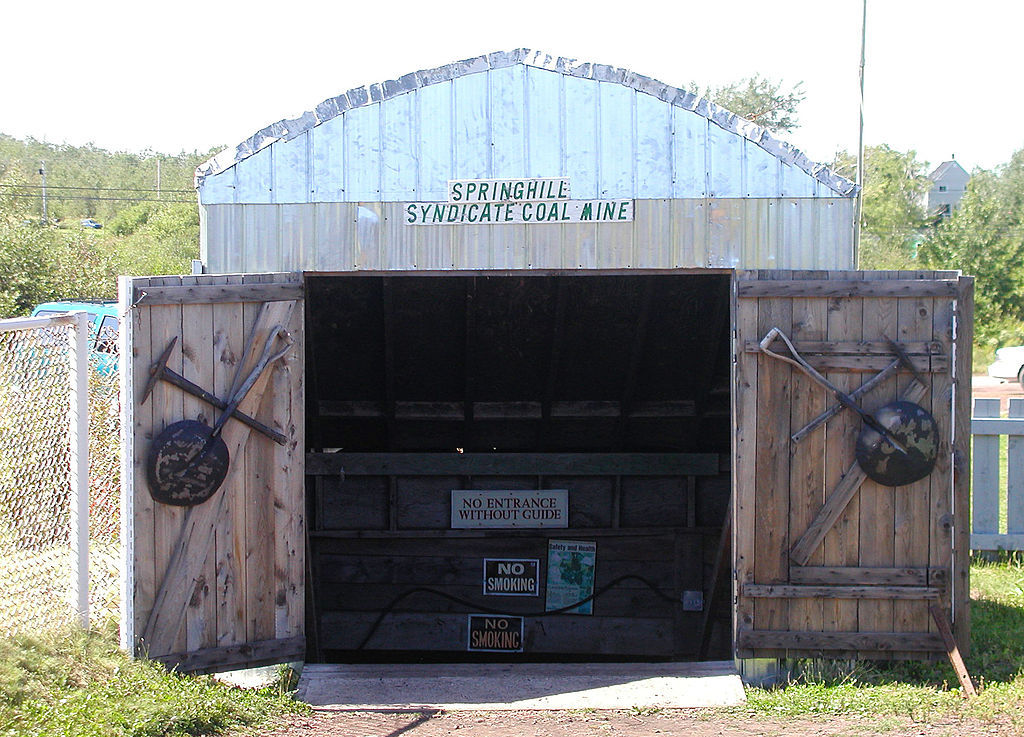
FROM WIKIPEDIA COMMONS
Springhill mining disaster may refer to any of three deadly Canadian mining disasters that occurred in 1891, 1956, and 1958 in different mines within the Springhill coalfield, near the town of Springhill in Cumberland County, Nova Scotia. In the 1891 accident, 125 died; in 1956, 39 were killed; and in 1958, there were 75 miners killed.
The mines in the Springhill coalfield were established in the 19th century, and by the early 1880s were being worked by the Cumberland Coal & Railway Company Ltd. and the Springhill & Parrsboro Coal & Railway Company Ltd. These entities merged in 1884 to form the Cumberland Railway & Coal Company Ltd., which its investors sold in 1910 to the industrial conglomerate Dominion Coal Company Ltd. (DOMCO). Following the third disaster in 1958, the operator Dominion Steel & Coal Corporation Ltd. (DOSCO), then a subsidiary of the A.V. Roe Canada Company Ltd., shut its mining operations in Springhill, and they were never reopened. As of 2015 the mine properties, among the deepest works in the world and filled with water, are owned by the government of Nova Scotia, and provide Springhill’s industrial park with geothermal heating.
1958 DISASTER AND EVENTS
The 1958 bump killed 75 miners on October 23, 1958, out of 174 working at the No. 2 colliery. The accident was the most severe “bump” (underground seismic event) in North American mining history and injured Springhill residents and devastated the town’s economy.
Springhill’s No. 2 colliery was one of the deepest coal mines in the world. Sloping shafts 14,200 feet (4,300 m) in length led to a vast labyrinth of galleries more than 4,000 feet (1,200 m) below the surface. Mining techniques there had been changed 20 years before the 1958 bump, from “room and pillar” to “long wall retreating” after reports had shown the increased danger of “bump” phenomena resulting from the former technique.
On October 23 a small bump occurred at 7:00 pm during the evening shift; it was ignored, as this was a somewhat common occurrence. However, just over an hour later, at 8:06 pm, an enormous bump “severely impacted the middle of the three walls that were being mined and the ends of the four levels nearest the walls”.
The bump spread as three distinct shock waves, resembling a small earthquake throughout the region, alerting residents on the surface over a wide area to the disaster. “Dräger” teams and teams of barefaced miners entered No. 2 colliery to begin the rescue effort. They encountered survivors at the 13,400-foot (4,100 m) level walking or limping toward the surface. Gas released by the bump was encountered in increasing concentrations at the 13,800-foot (4,200 m) level where the ceiling had collapsed, and rescuers were forced to work down shafts that were in a partial state of collapse or were blocked completely by debris.
Of the 174 miners in No. 2 colliery at the time of the bump, those who were not located either in side galleries, or some other shelter, were immediately crushed, the coal galleries and faces being completely destroyed. However, 75 survivors were on the surface by 4:00 am on October 24, 1958, and rescue teams continued working to find 24 others, but the number of rockfalls and the amount of debris slowed progress.
Meanwhile, the Canadian and international news media had made their way to Springhill. Arnie Patterson was the public relations spokesman for the Company, and relayed news of the progress of rescue (and later recovery) to the families of the miners and to reporters. The disaster became famous for being the first major international event to appear in live television broadcasts (on the CBC). As the world waited and those on the surface kept their vigil, rescuers continued to toil below ground trying to reach trapped survivors. Teams began to arrive from other coal mines in Cumberland County, on Cape Breton Island and in Pictou County.
After five and a half days (therefore around the morning of Wednesday, October 29, 1958), contact was established with a group of 12 survivors on the other side of a 160-foot (49 m) rockfall. A rescue tunnel was dug; it broke through to the trapped miners at 2:25 am on Thursday, October 30, 1958.
On Friday, October 31, 1958, the rescue site was visited by various dignitaries, including the Premier of Nova Scotia, Robert Stanfield, and His Royal Highness Prince Philip, the Duke of Edinburgh who had been at meetings in Ottawa.
On Saturday, November 1, 1958, another group of survivors was found. None were found thereafter. Instead, bodies of the dead were hauled out in airtight aluminum coffins, on account of the advanced stage of decomposition, accelerated by the Earth’s heat in the depths of No. 2 mine at 13,000–14,000 feet (4,000–4,300 m) below the mine entrance.
THE AFTERMATH
The 1958 bump had profound and long-lasting effects on the town and on the public imagination.
In the media crush at the pithead (the shaft entrance at the surface), reporters rushed to speak with survivors, particularly the two groups of miners who had been trapped until Thursday and Sunday respectively. When asked what he wanted most, survivor Douglas Jewkes replied, “A 7 Up“. Following this high-profile media event and unexpected “plug“, the 7 Up company hired him as a spokesman.
Several miners and their rescuers were invited onto The Ed Sullivan Show. One miner, Maurice Ruddick, was chosen as Canada’s “Citizen of the Year”. Ruddick and the other “miracle miners” enjoyed public attention for a brief time after their rescue. For Ruddick, the only black man in the group, racism dimmed his moment in the spotlight. An aide to the Democratic Governor of the U.S. state of Georgia Marvin Griffin took advantage of the intense media coverage to promote tourism to that state by offering a group of survivors free vacations to Jekyll Island. However to the segregationist governor’s chagrin (he had been vacationing on a hunting trip in Manitoba at the time of the disaster), he learned of Ruddick’s race – which resulted in a public relations nightmare. Upon learning that Ruddick was black, the governor said that Ruddick would have to be segregated. Ruddick agreed to the governor’s terms so that the other miners’ vacations would not be ruined; but he and his family stayed in a trailer apart from his colleagues. Ruddick died in 1988. In 2003, U.S. author Melissa Fay Greene retold this aspect of the aftermath in her book Last Man Out.
The rescuers were awarded a Gold Medal by the Royal Canadian Humane Association for bravery in lifesaving, the first time the medal had been awarded to a group. In 1958, the town of Springhill was awarded the Carnegie Medal for Heroism recognizing the community involvement needed to save the surviving miners. As of 2015, Springhill is the only community to have received that award, usually reserved for individual acts of heroism.
TODAY’S ALMANAC
Question of the Day
The autumn leaves seems to be hanging on longer than usual in my neck of the woods. Is this an indication of winter weather to come?
There’s an old weather proverb that states, “If autumn leaves are slow to fall, prepare for a cold winter.” Or perhaps you just haven’t had the kind of wind or rain needed to shake the leaves loose from their branches.
Advice of the Day
The swallows leave San Juan Capistrano, California, today.
Home Hint of the Day
Capping a chimney can make cleaning difficult and force the flames of a chimney fire down toward the roof, so install a chimney cap only if you have severe water or downdraft problems.
Word of the Day
Morning star
A planet that is above the eastern horizon at sunrise and less than 180° west of the Sun in right ascension.
Puzzle of the Day
Why is summer like the letter N?
Because it makes ice nice.
Born
- Francis Hopkinson Smith (author) – 1838
- John William Heisman (football player) – 1869
- William David Coolidge (physicist) – 1873
- Gertrude Ederle (first woman to swim the English Channel) – 1905
- Johnny Carson (comedian & television host) – 1925
- Pele (soccer player) – 1940
- Michael Crichton (author) – 1942
- Weird Al Yankovic (musician) – 1959
- Doug Flutie (football player) – 1962
- Ryan Reynolds (actor) – 1976
- Masiela Lusha (actress, author) – 1985
Died
- Zane Grey (author) – 1939
- Adolph Green (author & lyricist) – 2002
- Madame Chiang Kai-shek (became one of the world’s most famous women as she helped her husband fight the Japanese during World War II and later the Chinese Communists) – 2003
- Robert Merrill (baritone) – 2004
Events
- 25,000 women marched in New York City demanding the right to vote– 1915
- Charlie Chaplin married Mildred Harris– 1918
- Researchers at the University of Toronto announced the development of an electronic cardiac pacemaker– 1950
- Cumberland mine disaster– 1958
- Garfield the Cat’s lovable teddy bear, Pooky, made his comic strip debut– 1978
Weather
- Flood “swept all the fences off” in Newbury, Vermont– 1785
- Newbury, Vermont, received 12 inches of snow, which stayed until spring– 1843
- 1 foot of snow fell in Haverhill, New Hampshire– 1843
- A hurricane hit Philadelphia, Pennsylvania– 1878
- A tornado hit Cass County, Indiana, around mid-afternoon– 1971
- Major flooding occurred in Chickasha, Oklahoma– 2000
- The Neches River in southeast Texas was 8 feet above flood stage due to heavy rain– 2006
- Hurricane Patricia, a Category 5, became the strongest hurricane ever recorded in the Western hemisphere, with maximum sustained winds near 200 mph.– 2015
COURTESY www.almanac.com
